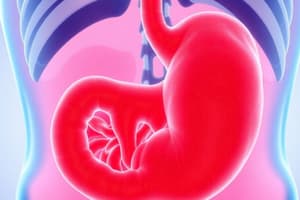Podcast
Questions and Answers
Qual é a principal causa das úlceras pépticas?
Qual é a principal causa das úlceras pépticas?
- Uso prolongado de anti-inflamatórios não esteroides (AINEs)
- Estresse emocional
- Excesso de ácido estomacal
- Infecção pela bactéria Helicobacter pylori (correct)
Qual sintoma NÃO está normalmente associado às úlceras pépticas?
Qual sintoma NÃO está normalmente associado às úlceras pépticas?
- Náusea e vômito
- Febre (correct)
- Dor abdominal
- Perda de apetite
Qual método de diagnóstico é comumente utilizado para identificar úlceras pépticas?
Qual método de diagnóstico é comumente utilizado para identificar úlceras pépticas?
- Exame de sangue
- Teste de urina
- Endoscopia (correct)
- Tomografia computadorizada
Qual é o tratamento recomendado para úlceras pépticas causadas por infecção por H. pylori?
Qual é o tratamento recomendado para úlceras pépticas causadas por infecção por H. pylori?
Qual é a principal medida de prevenção para úlceras pépticas causadas por AINEs?
Qual é a principal medida de prevenção para úlceras pépticas causadas por AINEs?
Qual das seguintes opções NÃO é um sintoma típico de úlceras pépticas?
Qual das seguintes opções NÃO é um sintoma típico de úlceras pépticas?
Flashcards are hidden until you start studying
Study Notes
Peptic Ulcers
Peptic ulcers refer to open sores or lesions that form in the lining of the stomach or duodenum, the first part of the small intestine. They are typically caused by the erosion of the mucous barrier that protects the stomach and intestines from digestive juices. Peptic ulcers are common, with approximately 10 million new cases diagnosed each year.
Causes
The primary causes of peptic ulcers include infection with the bacterium Helicobacter pylori (H. pylori) and the prolonged use of nonsteroidal anti-inflammatory drugs (NSAIDs) such as aspirin and ibuprofen.
Symptoms
Symptoms of peptic ulcers include abdominal pain, often described as a gnawing or burning sensation in the upper abdomen that may come and go for several days, bloating, loss of appetite, weight loss, belching, heartburn, nausea, vomiting, or blood in stools.
Diagnosis
Diagnosing peptic ulcers typically involves an endoscopy, which is a minimally invasive procedure using a flexible tube with a camera attached to examine the upper digestive tract. Other diagnostic tools include X-ray imaging techniques such as barium swallow x-rays and biopsy tests to detect H. pylori infection.
Treatment Options
Treatment for peptic ulcers depends on the underlying cause. For bacterial infections caused by H. pylori, antibiotic therapy along with antacids, acid blockers, or other drugs may be used. For NSAID-induced ulcers, discontinuing NSAIDs when possible often resolves the ulcer within two months. In severe cases, a combination of proton pump inhibitors (PPIs) and H2 receptor antagonists may be required.
Prevention
Preventing peptic ulcers primarily involves maintaining good hygiene habits to avoid H. pylori infection, reducing stress, avoiding smoking, and monitoring medication intake, especially NSAIDs.
Studying That Suits You
Use AI to generate personalized quizzes and flashcards to suit your learning preferences.




